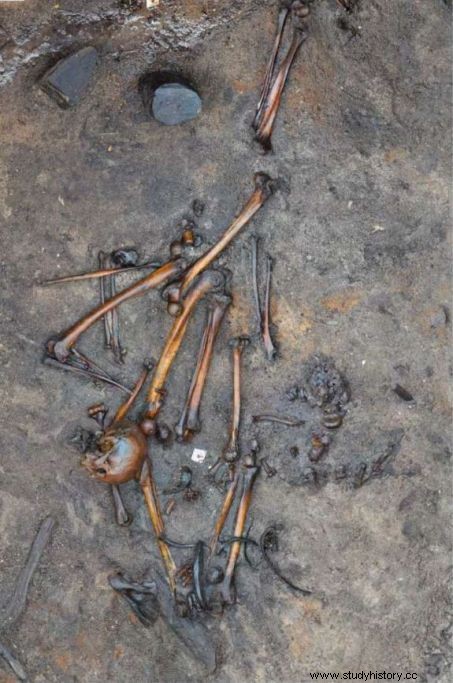Thousands of bone fragments from warriors killed in ruthless battles 2000 years ago have been discovered in a peat bog in Denmark.

Bone remains of several human pelvises strung on a stake, dated 2000 years, found at Alken Enge in Denmark.
Emaciated carcasses scraped to the bone, crushed skulls, pelvises impaled on stakes… Between 2009 and 2014, the remains of around a hundred people (1 st century AD. J.C) bearing traces of great violence, were exhumed from bogs in the lake region of Alken-Enge, near Skanderborg, in the eastern part of the Jutland peninsula (Denmark).
If there is no written memory of this confrontation, the experts who had to study these remains have just published their results in the American scientific journal Proceedings of the National Academy of Sciences . Found terribly mutilated, the dismembered and disarticulated bodies were extracted from an area of swamps and lakes of around 75 hectares, where they had been thrown 2000 years ago. Some apparently recycled into trophies! Thus, the macabre vision of four impaled basins as part of a probable ritual. "This is the earliest find of a large contingent of fighters from a defeated army dating back to the first century CE “, thus announced the researchers. “The bones are extremely well preserved ", told AFP Mette Løvschal, from the department of archeology at the University of Aarhus.
"There are traces on the bones that you don't usually see, such as animal bites or wounds from sharp weapons. It's very rare ", she added. Archaeologists have found more than 2000 of these human bones, buried in peat. Their radiocarbon dating places them between -2 BC and the year 54 AD.
Assembly of disarticulated human femurs and tibiae extracted from the Alken Enge marshes, Jutland Peninsula, Denmark. © PJ/University of Aarhus, Hojbjerg, Denmark
At this time, the legions of Rome were at their maximum expansion in northern Europe. In the year 7 BC. J.C, in their attempt to push this presence further east towards the Elbe, they had above all suffered one of the most serious defeats in their entire history. In the Teutoburg Forest (now Germany) thousands of Roman soldiers (3 legions) had been literally massacred by Germanic tribes. "During the following years, Rome then embarked on punitive campaigns, to chastise the Germanic barbarians and avenge this bitter defeat ", explains Mette Løvschal.
"At Alken-Enge, the excavated bones appear to come from a relatively heterogeneous population “, continued the researcher, “some bones belong to individuals aged 13 or 14, while others of men between 40 and 60 years old ". These bones bear witness to the way in which hand-to-hand combat may have taken place during the battle. The blows with the weapons thus seem to have been mainly struck on the right side. "Perhaps because these warriors wore a shield on their left arm “says the archaeologist. After spending several months on the battlefield, the corpses of the vanquished had to be fed to wolves or dogs. It was only once emaciated that what remained of the remains was thrown into the bogs.
Many gray areas remain
Such a reconstruction is necessarily partial, explain the researchers. And many questions still remain unanswered:who exactly faced each other that day? Are these remains the result of a Roman punitive expedition, or are they related to the internal wars fought by Germanic tribes in the face of the pressure exerted by the Roman advance? What meaning should be given to these pelvic bones strung on stakes? "You could almost see it as a form of humiliation with a sexual connotation ", suggests Mette Løvschal.
This violence on the bodies of defeated enemies was known to the Romans. The historian Tacitus (56-120 AD) had mentioned them in connection with the peoples of Northern Europe. Behaviors that also seem to date back to very ancient times. Recently, dating back to prehistoric times, skulls impaled on wooden spikes have been unearthed in Sweden, at the site of an ancient lake that has disappeared... They too bore the marks of great violence. These complex rituals with human deposits thus seem to have their roots in remote times among the ancient Scandinavians.
Revealing the scope of these outbursts of violence, archaeologists have also noted a revealing change in the geography of the place. The area in which these bones were found was previously covered with grasslands (enge) and forests. But during the 800 years that followed this carnage, a very dense forest returned to cover the place. "It says a lot about the enormous trauma that this event may have left on the people who lived there ", concluded Mette Løvschal.
With AFP

